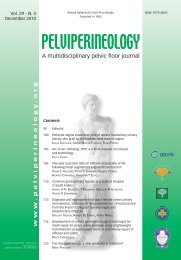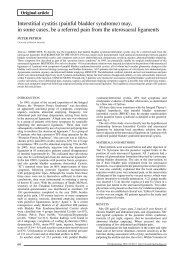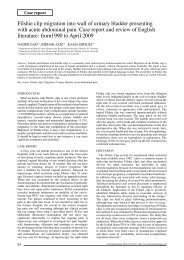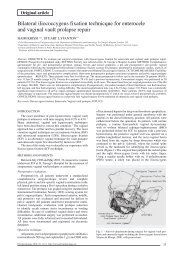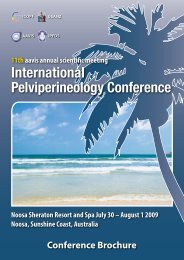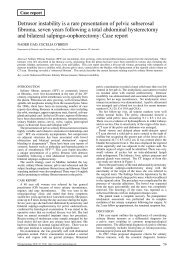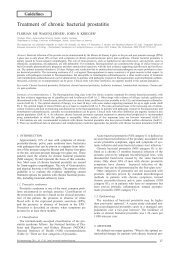Episiotomy repair europe - Pelviperineology
Episiotomy repair europe - Pelviperineology
Episiotomy repair europe - Pelviperineology
You also want an ePaper? Increase the reach of your titles
YUMPU automatically turns print PDFs into web optimized ePapers that Google loves.
Original article<br />
Material and type of suturing of perineal muscles<br />
used in episiotomy <strong>repair</strong> in Europe<br />
VLADIMIR KALIS - JIRI STEPAN Jr. - ZDENEK NOVOTNY - PAVEL CHALOUPKA<br />
MILENA KRALICKOVA - ZDENEK ROKYTA<br />
Department of Obstetrics and Gynecology, University Hospital, Faculty of Medicine, Charles University, Alej Svobody 80, 304 60 Plzen, Czech Republic<br />
Abstract: None of the trials evaluating episiotomy <strong>repair</strong> clearly focused on perineal muscles. The aim of this study was to describe suture<br />
material and styles of suturing perineal muscles in Europe by using an email and postal questionnaire. From 34 European countries, 122 hospitals<br />
agreed to participate. Thirteen different types of sutures are currently used. The most common material is polyglactin 910 (70%) followed<br />
by polyglycolic acid. Fifty one hospitals (46%) use only short-term and 49 hospitals (44%) use only mid-term absorbable synthetic sutures. In<br />
8 hospitals both types of sutures were used. The most common size of suture is 2-0 USP. Thirty percent of hospitals use continuous and 47%<br />
hospitals interrupted sutures for perineal muscle <strong>repair</strong>. In 23% of the hospitals there is not a uniform policy. The technique of suturing perineal<br />
muscles is diverse in Europe. It is unclear whether short-term absorbable synthetic suture should substitute mid-term absorbable synthetic<br />
material in the perineal muscle layer.<br />
Key words: <strong>Episiotomy</strong>; Practice variation; Perineum/Surgery; Episiorrhaphy; Suture technique.<br />
INTRODUCTION<br />
<strong>Episiotomy</strong>, the incision of the perineum during the last<br />
part of the second stage of labour or delivery is still considered<br />
a controversial procedure. Long-term complications<br />
after episiotomy <strong>repair</strong> are common. A large proportion<br />
of women suffer short-term perineal pain and up to 20%<br />
have longer-term problems (e.g. dyspareunia). 1 Other complications<br />
involve the removal of suture material, extensive<br />
dehiscence and the need for resuturing. 2<br />
According to an Italian study, episiotomy is associated<br />
with significantly lower values in pelvic floor functional<br />
tests, both in digital tests and in vaginal manometry, in comparison<br />
with women with intact perineum and first- and<br />
second-degree spontaneous perineal lacerations. 3 In another<br />
prospective trial of 87 patients, the pelvic floor muscle<br />
strength, assessed with the aid of vaginal cones, was significantly<br />
weaker in the episiotomy subgroup compared to a<br />
subgroup with spontaneous laceration. 4 A German study did<br />
not reveal any difference in the pelvic floor muscle strength<br />
between groups with restrictive and liberal use of episiotomy.<br />
5 None of these trials are specific about the type of<br />
suturing material used.<br />
Some of the trials evaluating episiotomy and its consequence<br />
regarding suturing material, focus on the type of<br />
sutures and a technique used for suturing the superficial<br />
layers (skin or subcuticular). 6<br />
If mid-term absorbable polyglycolic acid sutures were<br />
used for <strong>repair</strong>ing perineal muscles, a comparison to catgut<br />
7, 8, 9, 10 or chromic catgut 11, 12 was usually made.<br />
One trial compared mid-term absorbable polyglycolic acid<br />
(Dexon II) with a new monofilament suture glycomer 631<br />
(Biosyn). 13 There were significantly more problems associated<br />
with monofilament material at 8-12 weeks postpartum<br />
(suture removal due to discomfort and pain) which might be<br />
explained by the longer absorption time of glycomer 631. 13<br />
In a recent trial, in which only a short-term absorbable<br />
polyglactin 910 (Vicryl RAPIDE) is used, a continuous<br />
suture is compared to an interrupted technique and a continuous<br />
suture is found to be superior. 14<br />
To our knowledge, three trials have compared short- and<br />
mid-term synthetic absorbable suturing material. 15, 16, 17 In<br />
these, either only a standard mid-term absorbable polyglactin<br />
910 (Coated Vicryl) or only a short-term absorbable<br />
polyglactin 910 (Vicryl RAPIDE) was used for all layers<br />
(vaginal mucosa, perineal muscles, subcuticular/skin). All<br />
<strong>Pelviperineology</strong> 2008; 27: 17-20 http://www.pelviperineology.org<br />
of them focused on perineal pain and short-term complications<br />
of the <strong>repair</strong> and did not follow the pelvic floor muscle<br />
function.<br />
A small Danish randomized control trial (RCT) showed<br />
no difference in short- and long-term perineal pain, with<br />
a reduction in pain when walking on day 14 in a Vicryl<br />
RAPIDE group. Also, no difference was found between<br />
groups regarding episiotomy dehiscence. 15<br />
An Ulster study compared the same materials (Coated<br />
Vicryl and Vicryl RAPIDE).16 78 women were completed<br />
after birth with Coated Vicryl and 75 with Vicryl RAPIDE.<br />
At six and twelve weeks, a significant difference in the<br />
rates of wound problems (infection, gaping, pain, material<br />
removed) was found in favor of Vicryl RAPIDE. 16<br />
Kettle et al. performed a very well designed RCT with<br />
1542 women. 17 These were randomized into groups where<br />
either a standard mid-term absorbable polyglactin 910<br />
(coated Vicryl) or a short-term absorbable polyglactin 910<br />
(Vicryl RAPIDE) was used. The sutures of the perineal<br />
muscles and the skin were either, only interrupted, or only<br />
continuous, non-locking. The vaginal mucosa was always<br />
sutured continuously. This trial shows a clear benefit of the<br />
continuous technique compared to the interrupted. The pain<br />
at day 2, 10 and onwards up to 12 months postpartum was<br />
significantly lower in the continuous group. Also, all the<br />
other followed parameters (suture removal, uncomfortability,<br />
tightness, wound gaping, satisfaction with the <strong>repair</strong> and<br />
a return to normality within 3 months) were in favor of the<br />
continuous technique. 17<br />
Comparing the standard mid-term absorbable and shortterm<br />
absorbable polyglactin 910, in the parameter which differed<br />
most (suture removal), if sutures needed to be removed<br />
only visible transcutaneous sutures were removed from the<br />
continuous group. So the rate for suture removal, which was<br />
significantly lower for those who had received short-term<br />
absorbable polyglactin 910, is related to vaginal mucosa or<br />
skin and not to the sutures of perineal muscles. 17<br />
Pain at day 10 was not significantly different; however,<br />
some secondary pain measures (pain walking) were significant.<br />
17 The reduction in pain is achieved by inserting the<br />
skin sutures into the subcutaneous tissue and so avoiding<br />
nerve endings in the skin surface. 18 So the difference at<br />
day 10 might be explained by a different rate of absorption<br />
between Vicryl RAPIDE and Coated Vicryl and irritating<br />
nerve endings in the skin (and not in the muscles) by<br />
the remaining Coated Vicryl sutures. Vicryl RAPIDE is<br />
17
V. Kalis - J. Stepan Jr. - Z. Novotny - P. Chaloupka - M. Kralickova - Z. Rokyta<br />
absorbed in 42 days and its tensile strength is none (0 lb<br />
from original 10 lb) after two weeks. The suture begins to<br />
fall off in just 7 to 10 days. So this is ideal material if no<br />
wound tension after 7-10 days is acceptable. Coated Vicryl<br />
is absorbed in 56-70 days and its tensile strength is at 75%<br />
(10 lb from original 14 lb) after two weeks. 19<br />
No study has been clearly focused on the layer of perineal<br />
muscles. No study has as yet explored the advantage of new<br />
sutures with antibacterial properties for suturing the perineal<br />
muscles.<br />
DeLancey and Hurd show that urogenital hiatus is sealed<br />
by the vaginal walls, endopelvic fascia, and urethra. Once<br />
the urogenital hiatus has opened up, the vaginal wall and<br />
cervix lie unsupported. The constant vector of abdominal<br />
pressure on the fascia can cause its failure. It is ultimately<br />
the perineal body that is the mechanism for preventing prolapse<br />
beyond the urogenital hiatus. 20<br />
The layers traversed during uncomplicated mediolateral<br />
episiotomy are: epithelium, bulb of vestibule, Bartholin’s<br />
gland (occasionally), bulbospongiosis, superficial transverse<br />
perinei, perineal membrane, urethrovaginal sphincter and<br />
transversus vaginae. 21 Puborectalis muscle is rarely ever<br />
involved in this incision and so not afflicted by this procedure.<br />
When <strong>repair</strong>ing an episiotomy, the suture of perineal<br />
muscles seems to be the crucial step for an obstetrician or<br />
midwife in preventing a decrease in the pelvic floor muscle<br />
strength.<br />
The aim of this survey was to map the current situation in<br />
Europe and to describe common types of material and styles<br />
of suturing perineal muscles after episiotomy in European<br />
hospitals.<br />
MATERIALS AND METHODS<br />
In the year 2006, an email or postage questionnaire study<br />
was sent to different European hospitals. The question<br />
related to this project was as follows:<br />
Which type of material and methods of suturing are used<br />
in your hospital for perineal muscles?<br />
Hospitals of 27 EU countries, of 3 countries which had initiated<br />
entrance talks to the EU, plus Iceland, Israel, Norway<br />
and Switzerland, were asked to answer a mediolateral episiotomy<br />
questionnaire.<br />
RESULTS<br />
A total of 122 hospitals in 34 European countries participated<br />
in this project and sent back their answers. Sixty eight<br />
hospitals are situated in the original 15 EU countries, 44<br />
hospitals are from countries which entered the EU later or<br />
are involved in entrance talks, and 10 hospitals are located<br />
in the four remaining countries: Iceland, Israel, Norway and<br />
Switzerland.<br />
Type of suturing material<br />
A total of 110 hospitals reported that one type of suture<br />
material is used for perineal muscle <strong>repair</strong> while 12 hospitals<br />
answered that they use alternatively two types of sutures.<br />
None of the hospitals uses more than two different sutures<br />
in their standard approach.<br />
Altogether 13 different types of sutures are currently in<br />
use across Europe. These are shown in table 1.<br />
The most common suture type is a polyglactin 910 suture<br />
(Coated Vicryl, Vicryl RAPIDE or Vicryl PLUS Antibacterial),<br />
that is used in 96 hospitals (more than 70%). Polyglactin<br />
910 is followed by polyglycolic acid (Safil, Safil<br />
Quick, Dexon II), used by 16 hospitals (12%) and traditional<br />
gut sutures (catgut, chromic catgut) are used in 13 hospitals<br />
(10%). Non-absorbable suture was reported by only one<br />
18<br />
TABLE 1. – Material for suturing of perineal muscles.<br />
Material Mention<br />
(N) (%)<br />
1 Catgut 8 6<br />
2 Chromic catgut 5 3.5<br />
3 Dexon II 5 3.5<br />
4 Safil 7 5<br />
5 Safil Quick 4 3<br />
6 Coated Vicryl 40 29.5<br />
7 Vicryl RAPIDE 55 41<br />
8 Vicryl PLUS Antibacterial 1 1<br />
9 Monocryl 1 1<br />
10 Chirlac rapid braided 2 1.5<br />
11 Assucryl synthetic 1 1<br />
12 Polysorb 1 1<br />
13 Ethilon 1 1<br />
14 Not exactly specified<br />
absorbable material 3 2<br />
Total 134 100<br />
NB.: The total number amounts to 134 (12 hospitals use two materials<br />
alternatively).<br />
institution that also uses some other absorbable material.<br />
Catgut and/or chromic catgut are used as the only suture in<br />
11 hospitals (9%).<br />
Considering short- and mid-term absorbable synthetic<br />
sutures, we found that short-term absorbable sutures (Safil<br />
Quick, Vicryl RAPIDE, Chirlac rapid braided) are used by<br />
61 hospitals (50%). Mid-term absorbable sutures (Dexon<br />
II, Safil, Coated Vicryl, Vicryl PLUS Antibacterial, Assucryl<br />
synthetic, Polysorb) are used for suturing the perineal<br />
muscles in 55 hospitals (46%). Monocryl, whose absorption<br />
time is somewhere between short- and mid-term is used<br />
by one hospital. Only one hospital reported using a new<br />
absorbable synthetic suture with Triclosan (Vicryl PLUS<br />
Antibacterial), that has antibacterial properties.<br />
Fifty one hospitals (46%) use only short-term absorbable<br />
synthetic sutures and 49 (44%) use only mid-term absorbable<br />
sutures for perineal muscle <strong>repair</strong>. In 8 hospitals (8%)<br />
both types of sutures were used and 3 hospitals (2%) were<br />
not specific about their absorbable material.<br />
Size of the suturing material<br />
As for sizes of the sutures, we received 96 answers of<br />
which 3 hospitals referred to two alternative sizes. In 26<br />
remaining responses (8 using catgut only) the hospitals did<br />
not give details regarding the size of sutures used for perineal<br />
muscle <strong>repair</strong>.<br />
Among the hospitals which use only one type of material<br />
and only one size, the most frequent response was 2-0 Vicryl<br />
RAPIDE - 32 cases, followed by 0 and 2-0 Coated Vicryl,<br />
both reported by 13 institutions. All details are shown in<br />
table 2.<br />
Method of suturing of perineal muscles<br />
In the catgut group 5 hospitals did not answer. From the<br />
remaining 6 hospitals, only one hospital uses both techniques<br />
(continuous or interrupted), and a remaining 5 hospitals<br />
suture perineal muscles with interrupted stitches only.<br />
From 111 hospitals which use an absorbable synthetic<br />
material for suturing the muscles, 89 hospitals answered in<br />
full with 27 (30%) hospitals use continuous sutures, and 42<br />
(47%) hospitals interrupted sutures. Twenty (23%) hospi-
TABLE 2. – Sizes for sutures of perineal muscles.<br />
Size (USP) short-term absorbable sutures mid-term absorbable sutures<br />
tals do not have a uniform policy and leave the method of<br />
suturing to the discretion of the individual doctors (or midwives).<br />
DISCUSSION<br />
(N) (%) (N) (%)<br />
0 11 22 19 42<br />
2-0 38 74 21 47<br />
3-0 2 4 5 11<br />
Total 51 100 45 100<br />
NB.: Only answers for absorbable synthetic material shown.<br />
The choice of the suture depends on: properties of suture<br />
material, absorption rate, handling characteristics and knotting<br />
properties, size of suture, and the type of needle.<br />
Nearly a half of all European hospitals cooperating in this<br />
project use a mid-term synthetic absorbable suture for the<br />
suturing of perineal muscles. The other question put to participants<br />
in this questionnaire was analyzed in another article.<br />
22 In order to keep the question simple, there was not<br />
an additional request, if the same mid-term absorbable synthetic<br />
suture is used for all layers or for perineal muscles<br />
only. The majority of hospitals use interrupted sutures to<br />
approximate perineal muscles; the latter possibility is not<br />
excluded.<br />
It was also noted that a new synthetic material with antibacterial<br />
properties (Vicryl PLUS Antibacterial) is currently<br />
used by one institution.<br />
According to the meta-analysis, mid-term absorbable synthetic<br />
material for perineal <strong>repair</strong> is associated with less<br />
short-term pain compared to traditional gut sutures but with<br />
increased rates of removal. Further research with alternative<br />
suture materials is needed. 2 This disadvantage is reduced<br />
with short-term synthetic material and with a subcuticular<br />
continuous non-locking technique of episiotomy <strong>repair</strong>. 17<br />
However, the information regarding suturing material of<br />
perineal muscles is not extensive.<br />
There is a recommendation that a short-term synthetic<br />
absorbable suture (Vicryl RAPIDE) is a preferential material<br />
for all three layers in an episiotomy <strong>repair</strong> and so episiotomy<br />
can be sutured in a loose continuous non-locking technique<br />
with only two knots (at the beginning and at the end). 23<br />
However, according to Ethicon Sutures Homepage, a<br />
short-term absorbable suture (Vicryl RAPIDE) is suggested<br />
for superficial closure of mucosa or skin closure for patients<br />
not returning for another check-up. 19 A mid-term absorbable<br />
suture (Coated Vicryl) should be used for general tissue<br />
and muscle approximation. 19 A new mid-term absorbable<br />
suture (Vicryl PLUS Antibacterial) has the same indication<br />
as Coated Vicryl and should be used when extra caution<br />
is desired (i.e. potentially high risk surgical sites). 19 More<br />
information is needed to find the potential benefit of Triclosan<br />
in perineal <strong>repair</strong>.<br />
On the other hand the Aesculap web page recommends<br />
a short-term absorbable suture (Safil Quick) for an episiotomy<br />
<strong>repair</strong> in Gynaecology and Obstetrics without further<br />
specification. 24<br />
In the review of the management of obstetric sphincter<br />
injury, great care should be exercised in reconstructing the<br />
perineal muscles to provide support to the sphincter <strong>repair</strong>.<br />
Muscles of the perineal body should be reconstructed with<br />
Vicryl 2-0 sutures. 25<br />
Material and type of suturing of perineal muscles used in episiotomy <strong>repair</strong> in Europe<br />
It might happen that a short-term absorbable synthetic<br />
suture does not necessarily hold the approximated torn muscles<br />
for a sufficient time. However this assumption is not<br />
based on any evidence.<br />
There is a consensus that a short-term absorbable synthetic<br />
suture is the best choice for vaginal mucosa and perineal<br />
skin. The suturing the mucosa and perineal skin with a<br />
short-term absorbable synthetic suture and perineal muscles<br />
with a mid-term absorbable synthetic suture would bring<br />
additional expenditures for any institutional budget. The<br />
production of a prefabricated episiotomy set, where both<br />
sutures would be available, could reduce this increase in<br />
costs. An episiotomy set already exists in several hospitals.<br />
Also, in this era of reducing adjacent episiotomies, this additional<br />
expenditure would not be so dramatic compared to the<br />
financial implications of anal sphincter <strong>repair</strong>.<br />
Currently, the type of material, its size and the technique<br />
of suture is not a controversial topic regarding vaginal<br />
mucosa and perineal skin. However, the style of suturing of<br />
perineal muscles has not yet been fully explored. This European<br />
survey serves to document this ambiguity. Further well<br />
designed RCTs are required to focus on the real role of the<br />
perineal muscles after vaginal birth and the best method of<br />
their <strong>repair</strong>. These RCTs must also comprise the exact depiction<br />
of cutting of episiotomy and all details with regards to<br />
the <strong>repair</strong>.<br />
This survey shows that there is much diversity in the technique<br />
of suturing of perineal muscles across Europe. It is<br />
not clear enough if short-term absorbable synthetic suture<br />
should substitute mid-term absorbable synthetic material in<br />
this layer, as it did for vaginal mucosa and perineal skin.<br />
On the basis of information obtained from 122 European<br />
hospitals, the authors of this survey would like to cooperate<br />
in a multicentric trial to obtain more information.<br />
REFERENCES<br />
1. Buhling KJ, Schmidt S, Robinson JN, et al. Rate of dyspareunia<br />
after delivery in primiparae according to mode of delivery.<br />
Eur J Obstet Gynecol Reprod Biol 2006; 24: 42-46.<br />
2. Kettle C, Johanson RB. Absorbable synthetic versus catgut<br />
suture material for perineal <strong>repair</strong>. Cochrane Database Syst<br />
Rev. 2000: CD000006.<br />
3. Sartore A, De Seta F, Maso G, et al. The effects of mediolateral<br />
episiotomy on pelvic floor function after vaginal delivery.<br />
Obstet Gynecol. 2004; 103: 669-673.<br />
4. Rockner G, Jonasson A, Olund A. The effect of mediolateral<br />
episiotomy at delivery on pelvic floor muscle strength evaluated<br />
with vaginal cones. Acta Obstet Gynecol Scand 1991; 70:<br />
51-54.<br />
5. Dannecker C, Hillemanns P, Strauss A, et al. <strong>Episiotomy</strong> and<br />
perineal tears presumed to be imminent: the influence on the<br />
urethral pressure profile, analmanometric and other pelvic floor<br />
findings--follow-up study of a randomized controlled trial.<br />
Acta Obstet Gynecol Scand. 2005; 84: 65-71.<br />
6. Mackrodt C, Gordon B, Fern E, et al. The Ipswich Childbirth<br />
Study: 2. A randomised comparison of polyglactin 910 with<br />
chromic catgut for postpartum perineal <strong>repair</strong>. Br J Obstet<br />
Gynaecol. 1998; 105: 441-445.<br />
7. Livingstone E, Simpson D, Naismith WC. A comparison<br />
between catgut and polyglycolic acid sutures in episiotomy<br />
<strong>repair</strong>. J Obstet Gynaecol Br Commonw 1974; 81: 245-247.<br />
8. Olah KS. <strong>Episiotomy</strong> <strong>repair</strong>-suture material and short term<br />
morbidity. J Obstet Gynaecol 1990; 10: 503-505.<br />
9. Isager-Sally L, Legarth J, Jacobsen B, Bostofte E. <strong>Episiotomy</strong><br />
<strong>repair</strong>-immediate and long-term sequelae. A prospective randomized<br />
study of three different methods of <strong>repair</strong>. Br J Obstet<br />
Gynaecol. 1986; 93: 420-425.<br />
10. Roberts AD, McKay Hart D. Polyglycolic acid and catgut<br />
sutures, with and without oral proteolytic enzymes, in the healing<br />
of episiotomies. Br J Obstet Gynaecol. 1983; 90: 650-653.<br />
19
V. Kalis - J. Stepan Jr. - Z. Novotny - P. Chaloupka - M. Kralickova - Z. Rokyta<br />
11. Banninger U, Buhrig H, Schreiner WE. A comparison between<br />
chromic catgut and polyglycolic acid sutures in episiotomy<br />
<strong>repair</strong>. Geburtshilfe Frauenheilkd 1978; 38: 30-33.<br />
12. Mahomed K, Grant A, Ashurst H, James D. The Southmead<br />
perineal suture study. A randomized comparison of suture<br />
materials and suturing techniques for <strong>repair</strong> of perineal trauma.<br />
Br J Obstet Gynaecol. 1989; 96: 1272-1280.<br />
13. Dencker A, Lundgren I, Sporrong T. Suturing after childbirth<br />
– a randomised controlled study testing a new monofilament<br />
material. BJOG 2006; 113: 114-116.<br />
14. Morano S, Mistrangelo E, Pastorino D, et al. A randomized<br />
comparison of suturing techniques for episiotomy and laceration<br />
<strong>repair</strong> after spontaneous vaginal birth. J Minim Invasive<br />
Gynecol. 2006; 13: 457-462.<br />
15. Gemynthe A, Langhoff-Roos J, Sahl S, Knudsen J. New<br />
VICRYL formulation: an improved Metod of perineal <strong>repair</strong>?<br />
Br J Midwifery 1996; 4: 230-234.<br />
16. McElhinney BR, Glenn DR, Dornan G, Harper MA. <strong>Episiotomy</strong><br />
<strong>repair</strong>: Vicryl versus Vicryl rapide. Ulster Med J. 2000;<br />
69: 27-29.<br />
17. Kettle C, Hills RK, Jones P, et al. Continuous versus interrupted<br />
perineal <strong>repair</strong> with standard or rapidly absorbed sutures<br />
after spontaneous vaginal birth: a randomised controlled trial.<br />
Lancet. 2002; 359: 2217-2223.<br />
18. Fleming N. Can the suturing method make a difference in postpartum<br />
perineal pain? J Nurse Midwifery. 1990; 35: 19-25.<br />
20<br />
Pelvic Floor Digest<br />
6 – INCONTINENCES<br />
continued from page 11<br />
19. http://www.ethicon.novartis.us<br />
20. DeLancey JOL, Hurd WW. Size of the urogenital hiatus in the<br />
levator ani muscles in normal women and women with pelvic<br />
organ prolapse. Obstet Gynecol. 1998; 91: 364-368.<br />
21. Sultan AH, Kamm MA, Hudson CN. Obstetric perineal trauma:<br />
an audit of training. J Obstet Gynaecol 1995; 15: 19-23.<br />
22. Kalis V, Stepan J. Jr., Horak M., Roztocil A., Kralickova M.,<br />
Rokyta Z. Definitions of Mediolateral <strong>Episiotomy</strong> in Europe.<br />
Int J Gynaecol Obstet 2008; 100: 188-189.<br />
23. RCOG Guideline No. 23. Methods and materials used in perineal<br />
<strong>repair</strong>. June 2004.<br />
24. http://www.aesculapusa.com<br />
25. Thakar R, Sultan AH. The Obstetrician and Gynaecologist.<br />
2003; 5: 31-39.<br />
Correspondence to:<br />
VLADIMIR KALIS<br />
Department of Obstetrics and Gynecology, University Hospital,<br />
Faculty of Medicine, Charles University<br />
Alej Svobody 80, 304 60 Plzen, Czech Republic<br />
Tel: +420 377 105 212 (work), +420 777 067 699 (mobile)<br />
Fax: +420 377 105 290<br />
E-mail: kalisv@fnplzen.cz<br />
The impact of fecal (FI) and urinary incontinence (UI) on quality of life 6 months after childbirth. Handa VL, Zyczynski HM, Burgio KL<br />
et al. Am J Obstet Gynecol. 2007;197:636. With validated questionnaires 759 primiparous women were assessed for FI and UI six months<br />
postpartum, measuring QOL with SF-12 summary scores, health utility index score (a measure of self-rated overall health), and the modified<br />
Manchester Health Questionnaire. Women with FI and those with UI had worse scores than women without incontinences or flatal incontinence<br />
only. FI and UI together have a greater impact than either condition alone.<br />
The impact of tension-free vaginal tape on overactive bladder symptoms in women with stress urinary incontinence: significance of<br />
detrusor overactivity. Choe JH, Choo MS, Lee KS. J Urol. 2007 Nov 12; epub. Evaluating the results of the TVT in 549 women (2003 to 2004)<br />
it is concluded that the tension-free vaginal tape procedure can be performed in women with stress urinary incontinence and overactive bladder<br />
including urge incontinence even if the patient has detrusor overactivity on urodynamic study. However, patients should be fully advised of the<br />
possibility of persistent overactive bladder symptoms and treatment for those symptoms after tension-free vaginal tape should be Ĝ" # o$ % & '<br />
Myoblast and fibroblast therapy for post-prostatectomy urinary incontinence: 1-year followup of 63 patients. Mitterberger M, Marksteiner<br />
R, Margreiter E et al. J Urol. 2007 Nov 12; epub. Transurethral ultrasound guided injections of autologous fibroblasts and myoblasts<br />
obtained from skeletal muscle biopsies were done in 63 patients with stress urinary incontinence after radical prostatectomy were treated with.<br />
One year after implantation 41 patients were continent, 17 showed improvement and 5 failed. Thickness and contractility of the rhabdosphincter<br />
were significantly improved postoperatively.<br />
Behavioral comorbidity differs in subtypes of enuresis and urinary incontinence. Zink S, Freitag CM, Gontard AV. J Urol. 2007 Nov 13;<br />
epub. Different subtypes of enuresis and urinary incontinence demonstrate differences in behavioral problems and psychiatric comorbidity.<br />
The highest rates of psychiatric comorbidity were found in the group of children with voiding postponement and the lowest were in children<br />
with monosymptomatic nocturnal enuresis. Screening for comorbid psychiatric disorders in children with enuresis and urinary incontinence is<br />
highly recommended, and further investigations in large groups of children are necessary.<br />
Evaluation and outcome measures in the treatment of female urinary stress incontinence: International Urogynecological Association<br />
(IUGA) guidelines for research and clinical practice. Ghoniem G, Stanford E, Kenton K et al. Int Urogynecol J Pelvic Floor Dysfunct.<br />
2008;19:5.<br />
The age distribution, rates, and types of surgery for stress urinary incontinence (SUI) in the USA. Shah AD, Kohli N, Rajan SS, Hoyte<br />
L. Int Urogynecol J Pelvic Floor Dysfunct. 2008;19:89. The distribution of SUI surgery across age groups in the USA in 2003 was studied:<br />
129,778 women underwent 165,776 surgical procedures. Of these women, 12.2, 53.0, 30.4, and 4.5% belonged to reproductive, perimenopausal,<br />
postmenopausal, and elderly age groups, respectively. Surgical rates (per 10,000 women) were 4, 17, 19, and 9 in these age groups,<br />
respectively. Complications occurred most frequently in reproductive age women. Women at all stages of reproductive life may seek surgical<br />
treatment for SUI, but the greatest percentage of surgical procedures occurred in perimenopausal women.<br />
Clinical and urodynamic outcomes of pubovaginal sling procedure with autologous rectus fascia for stress urinary incontinence. Mitsui<br />
T, Tanaka H, Moriya K et al. Int J Urol. 2007;14:1076. Pubovaginal sling surgery with autologous rectus fascia was done in 29 consecutive<br />
women with SUI. Overall SUI was cured in 23 patients and improved in 3 patients. Three patients who developed persistent urinary retention<br />
or severe voiding difficulty after surgery underwent urethrolysis. Of 17 patients who had urgency before the pubovaginal sling, urgency was<br />
cured postoperatively in seven, while de novo urgency appeared in one patient. Postvoid residual urine volume (PVR) >100 mL and Qmax<br />
Pelvic Floor Digest<br />
Mixed urinary incontinence: continuing to confound? Hockey J. Curr Opin Obstet Gynecol. 2007;19:521. Mixed incontinence is a complex<br />
clinical problem for urogynaecologists and generalists alike, as research for new treatments tend to focus on single-symptom groups. Those<br />
with mixed symptoms form a diverse group, which is difficult to study precisely. Recent studies, however, have aimed to classify the subgroups<br />
into predominant types to determine the response to treatment with greater accuracy.<br />
Transobturator tapes for stress urinary incontinence: results of the Austrian registry. Tamussino K, Hanzal E, Kolle D et al. Am J Obstet<br />
Gynecol. 2007;197:634. Data on a total of 2543 operations with 11 different tape systems were collected. Intraoperative complications were<br />
noted for 120 procedures (4.7%): increased bleeding, vaginal, bladder and urethral perforations. Reoperations attributable to the tape procedure<br />
were reported for 57 patients (24 tapes cut or loosened for voiding dysfunction, 11 vaginal erosions, 7 abscesses with erosions). Significant<br />
postoperative pain was reported for 12 patients (0.5%).<br />
National audit of continence care for older people: management of urinary incontinence. Wagg A, Potter J, Peel P et al. Age Ageing. 2007<br />
Nov 21; epub. A national audit was conducted across England, Wales and Northern Ireland. The results indicate that assessment and care by<br />
professionals directly looking after the older person were often lacking. There is an urgent need to re-establish the fundamentals of continence<br />
care into the practice of medical and nursing staff and action needs to be taken with regard to the establishment of truly integrated, quality<br />
services in this neglected area of practice.<br />
The inside-out trans-obturator sling: a novel surgical technique for the treatment of male urinary incontinence. de Leval J, Waltregny D.<br />
Eur Urol. 2007 Nov 20; epub. A new polypropylene sling procedure for treating stress urinary incontinence (SUI) after radical prostatectomy<br />
(RP) is pulled for compressing the bulbar urethra upward and tied to each other across the midline. Patients with detrusor overactivity are<br />
excluded. At 6 months 45% patients were cured and 40% improved (1pad/d), so this procedure appears to be safe and efficient at short term.<br />
Further studies are warranted to determine long-term outcome.<br />
Long-term follow-up of a transvaginal Burch urethropexy for stress urinary incontinence. Rardin CR, Sung VW, Hampton BS et al. Am<br />
J Obstet Gynecol. 2007;197:656. A vaginal Burch urethropexy for urodynamic stress urinary incontinence with urethral hypermobility was<br />
performed in 66 women using a suture carrier device. Concurrent prolapse <strong>repair</strong>s were performed as indicated. Mean follow-up time was 20.9<br />
+/- 18.9 months. Objective failure was observed in 16 patients (24.2%). Subjective failure was reported by 21.2% of patients, with 50% and<br />
28.8% reporting success and improvement, respectively. Six patients (9%) experienced febrile illness, 4 (6%) intraoperative hemorrhage, 1<br />
pelvic abscess, 12 (18.2%) suture erosion; half required surgical revision or excision. It is concluded that vaginal Burch urethropexy is well<br />
tolerated but is associated with poor long-term success and high suture erosion rates.<br />
Complication rates of tension-free midurethral slings in the treatment of female stress urinary incontinence: a systematic review<br />
and meta-analysis of randomized controlled trials comparing tension-free midurethral tapes to other surgical procedures. Novara G,<br />
Galfano A, Boscolo-Berto R, Secco S, Cavalleri S, Ficarra V, Artibani W. Eur Urol. 2007 Nov 8; epub. To evaluate the complication rates of<br />
tension-free midurethral slings compared with other surgical treatments for stress urinary incontinence a systematic review of the literature<br />
using MEDLINE, EMBASE, and Web of Science identified 33 randomized controlled trials reporting data on complication rates. Tensionfree<br />
slings were followed by lower risk of reoperation compared with Burch colposuspension, whereas pubovaginal sling and tension-free<br />
midurethral slings had similar complication rates. With regards to different tension-free tapes, voiding LUTS and reoperations were more<br />
common after SPARC, whereas bladder perforations, pelvic haematoma, and storage LUTS were less common after transobturator tapes. The<br />
quality of many evaluated studies was limited.<br />
Botulinum toxin A (Botox((R)) intradetrusor injections in adults with neurogenic detrusor overactivity/neurogenic overactive bladder<br />
(NDO/NOAB): a systematic literature review. Karsenty G, Denys P, Amarenco G et al. Eur Urol. 2007 Oct 16; epub. A total of 18 articles<br />
evaluating the efficacy or safety of Botox in patients resistant to antimuscarinic therapy, with or without clean intermittent self-catheterisation<br />
(CIC), were selected. Most of the studies reported a significant improvement in clinical (approximately 40-80% of patients became completely<br />
dry between CICs) as well as urodynamic (in most studies mean maximum detrusor pressure was reduced to



